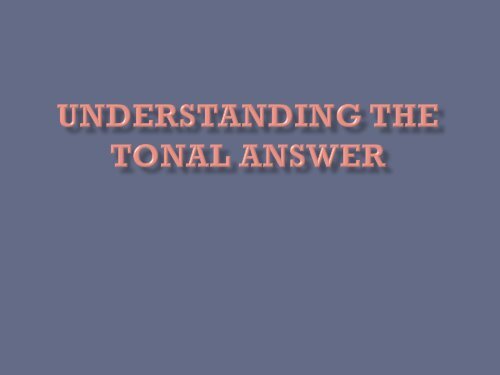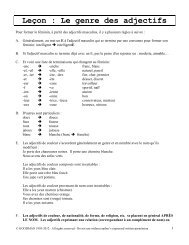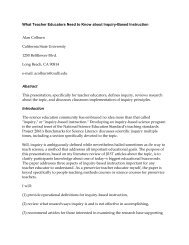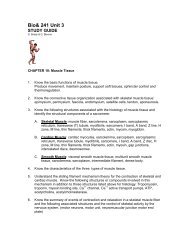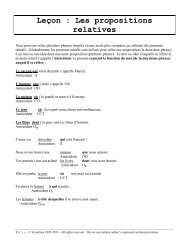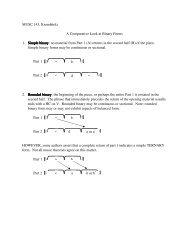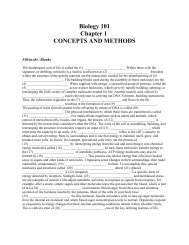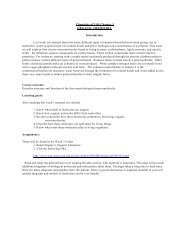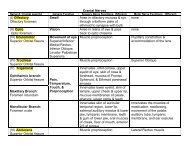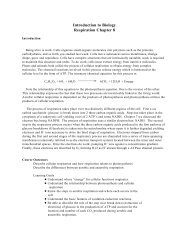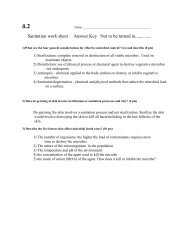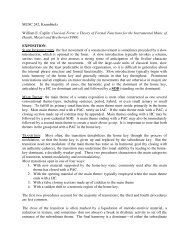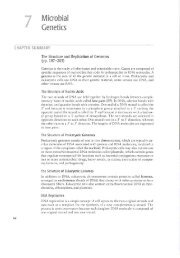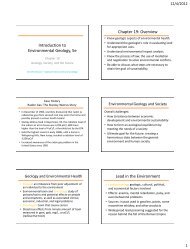Understanding the Tonal Answer
Understanding the Tonal Answer
Understanding the Tonal Answer
Create successful ePaper yourself
Turn your PDF publications into a flip-book with our unique Google optimized e-Paper software.
• The melodic structure of <strong>the</strong> fugue subject must<br />
establish <strong>the</strong> key clearly.<br />
• Therefore, many fugue subjects emphasize members<br />
of <strong>the</strong> tonic triad, particularly ^1 and ^5.<br />
• A fugue subject often contains a rhythmic or<br />
melodic characteristic (or both) that makes it easy<br />
to hear later in <strong>the</strong> piece.
• This restatement is almost always in <strong>the</strong> dominant<br />
key (V or v) and takes one of two forms:<br />
• An exac transposition into <strong>the</strong> dominant key, called a real<br />
answer.<br />
• A transposed version in <strong>the</strong> dominant key that contains<br />
one or more slight alterations, called a tonal answer.
• First, if given a fugue subject to which you will<br />
write an answer, you will learn whe<strong>the</strong>r <strong>the</strong> subject<br />
requires a tonal answer, and<br />
• Second, if you need to write a tonal answer, you<br />
will learn how to make <strong>the</strong> correct stylistic<br />
alterations to <strong>the</strong> answer.
• Why do composers use tonal answers? Why not<br />
simply transpose <strong>the</strong> answer to <strong>the</strong> dominant and be<br />
done with it?<br />
• To begin to understand <strong>the</strong>se questions, let’s start<br />
with a typical fugue subject.
• Here is J. S. Bach’s subject to <strong>the</strong> Art of Fugue. As<br />
with most subjects, <strong>the</strong> tonic harmony is established<br />
right at <strong>the</strong> outset.
• Now here is a real answer to <strong>the</strong> above subject. The<br />
subject is simply transposed to <strong>the</strong> (minor)<br />
dominant key.
In actual practice, <strong>the</strong> answer enters when <strong>the</strong> subject<br />
reaches its final note:
• But <strong>the</strong>re’s a problem: when <strong>the</strong> answer enters in m.<br />
5 <strong>the</strong> underlying harmony at that point is D minor,<br />
which is no surprise since <strong>the</strong> subject ends on ^1.<br />
The changes to a minor in <strong>the</strong> following measure.<br />
• The answer’s second note, E, clashes with this tonic<br />
harmony:
• Change <strong>the</strong> subject’s ending harmony (thus<br />
destroying <strong>the</strong> sense of tonic associated with <strong>the</strong><br />
ending of <strong>the</strong> subject)? Or,<br />
• Alter <strong>the</strong> answer to accommodate <strong>the</strong> harmony?<br />
Composers opted for <strong>the</strong> second option:
• Note that we had to change only ONE note of <strong>the</strong><br />
answer to accommodate <strong>the</strong> underlying harmony.<br />
(This is <strong>the</strong> solution that Bach uses, by <strong>the</strong> way.)
Assume that a fugue subject will take a real answer<br />
unless one of <strong>the</strong> following three conditions exist:<br />
1. The subject begins on ^5 and does not modulate.<br />
2. ^1 and ^5 occur very close to one ano<strong>the</strong>r at <strong>the</strong><br />
outset of <strong>the</strong> subject (very often <strong>the</strong> first two notes)<br />
and <strong>the</strong> subject do not modulate. Or,<br />
3. The subject modulates to <strong>the</strong> dominant.
• <strong>Answer</strong>s to <strong>the</strong>se type of subjects usually require<br />
only a single alteration: start <strong>the</strong> answer on ^1 and<br />
transpose <strong>the</strong> rest of <strong>the</strong> subject to <strong>the</strong> dominant key.<br />
• Consider this subject by J. G. Wal<strong>the</strong>r (J. S. Bach’s<br />
uncle):
• The subject starts on ^5, so we begin <strong>the</strong> answer on ^1.<br />
(Although <strong>the</strong>re are three eighth notes on ^5, <strong>the</strong>y<br />
represent a single pitch, so we change all of <strong>the</strong><br />
corresponding notes to ^1. )<br />
• Then transpose <strong>the</strong> remainder of <strong>the</strong> subject up a P5.
• These are a very common type of subject: <strong>the</strong><br />
subject starts on ^1 and <strong>the</strong>n leaps to ^5.<br />
• Usually only one alteration is necessary: answer ^5<br />
with ^1. Thus, if <strong>the</strong> subject begins ^1ÿ^5, <strong>the</strong> answer<br />
begins ^5ÿ^1.<br />
• Write <strong>the</strong> rest of <strong>the</strong> answer up a P5.
• Consider <strong>the</strong> fugue subject by Bach:
• ^1 at <strong>the</strong> opening of <strong>the</strong> subject is answered<br />
by ^5.<br />
• ^5 at <strong>the</strong> opening of <strong>the</strong> subject is answered<br />
by ^1.<br />
Although set in <strong>the</strong> dominant key, <strong>the</strong> answer is<br />
initially harmonized with <strong>the</strong> tonic chord of <strong>the</strong><br />
home key, not <strong>the</strong> tonic key of <strong>the</strong> dominant. The<br />
exchange of ^1 and ^5 remains in place as long as <strong>the</strong><br />
home key tonic is <strong>the</strong> underlying harmony.
• Modulating fugue subjects are uncommon<br />
• The new key is always V.<br />
• The answer MUST modulate back to I (i), because<br />
to allow <strong>the</strong> answer to modulate up to its dominant<br />
is unacceptable so early in <strong>the</strong> fugue (C Å G Å D?).<br />
• At some point, <strong>the</strong> answer is transposed up only a<br />
P4 instead of a P5 (C Å G Å C).<br />
• There is no definite formula for answering<br />
modulating fugue subjects that works in all cases.
Charles Nalden (Fugal <strong>Answer</strong>, 1969) groups fugue<br />
subjects into three melodic types, which determine<br />
where <strong>the</strong> P4 transposition will occur:<br />
1. Subjects whose opening is marked with a<br />
prominently placed ^1 and ^5.<br />
2. Subjects whose melodic line is marked by a<br />
division (usually a rest or implied cadence).<br />
3. Subjects with an ‘indivisible’ or ‘unyielding’ melodic<br />
line.
• The alteration takes place at <strong>the</strong> beginning of <strong>the</strong><br />
answer. Once <strong>the</strong> typical exchange of ^1 and ^5 takes<br />
place, transpose <strong>the</strong> rest of <strong>the</strong> answer up a 4 th .<br />
• Consider this subject:
• Simply make <strong>the</strong> exchange of ^1 and ^5 and <strong>the</strong>n<br />
transpose <strong>the</strong> rest of <strong>the</strong> subject up a P4. (Note that<br />
<strong>the</strong> use of ^1 in <strong>the</strong> answer already represents<br />
transposition by P4 anyway.)
• In <strong>the</strong> actual context it sounds:
• Look for a rest or implied ‘cadence’ (on <strong>the</strong> tonic<br />
chord).<br />
• The alteration takes place immediately after this<br />
point.<br />
In this first example, <strong>the</strong> change takes place near <strong>the</strong><br />
beginning of <strong>the</strong> subject, following <strong>the</strong> eighth rest.


